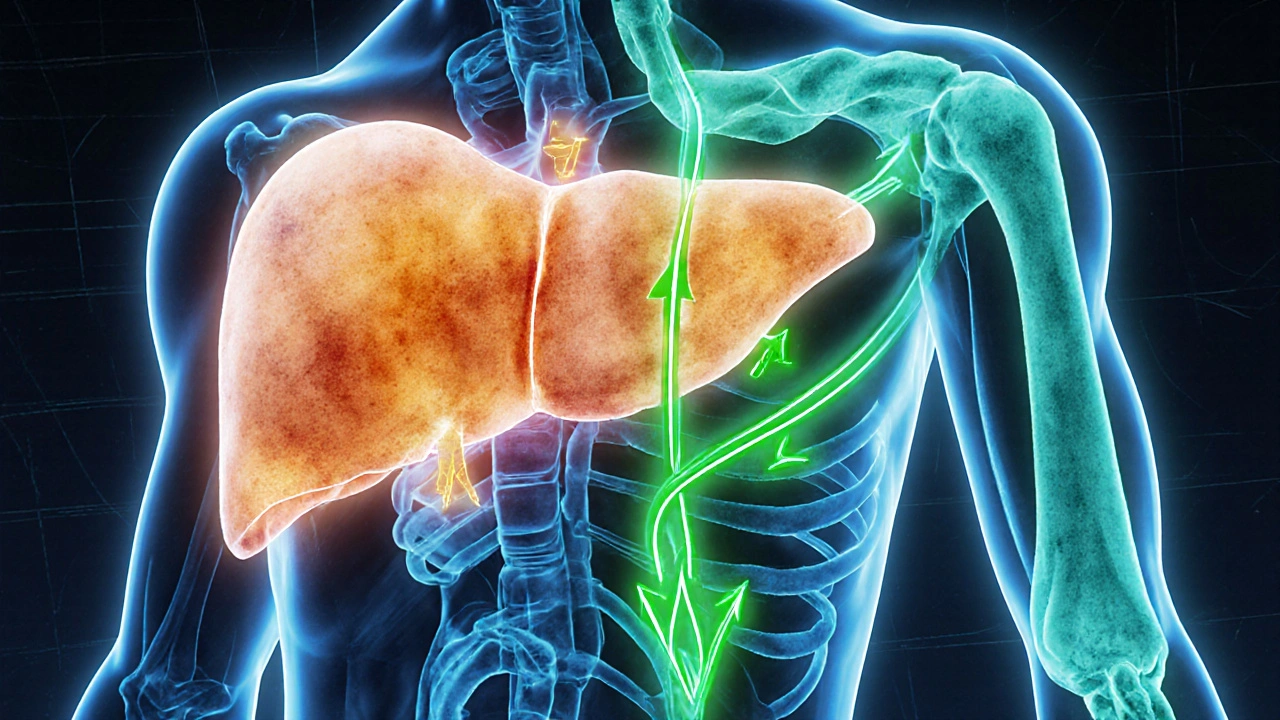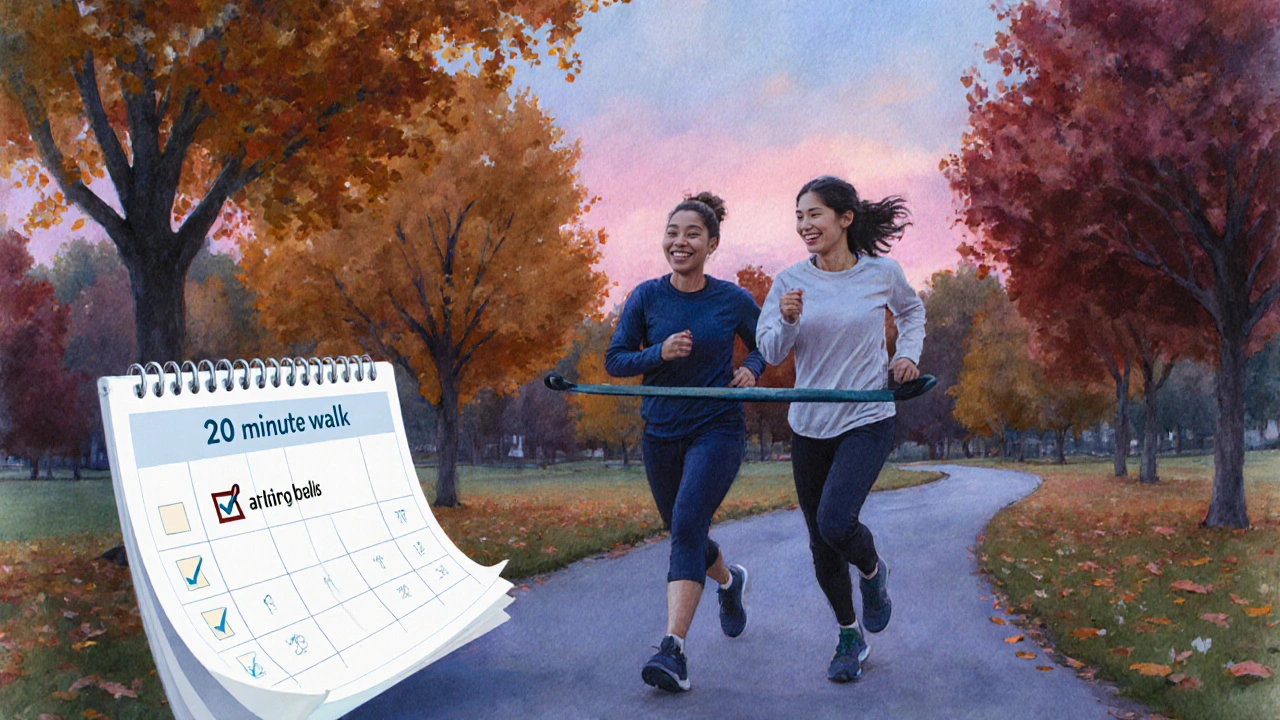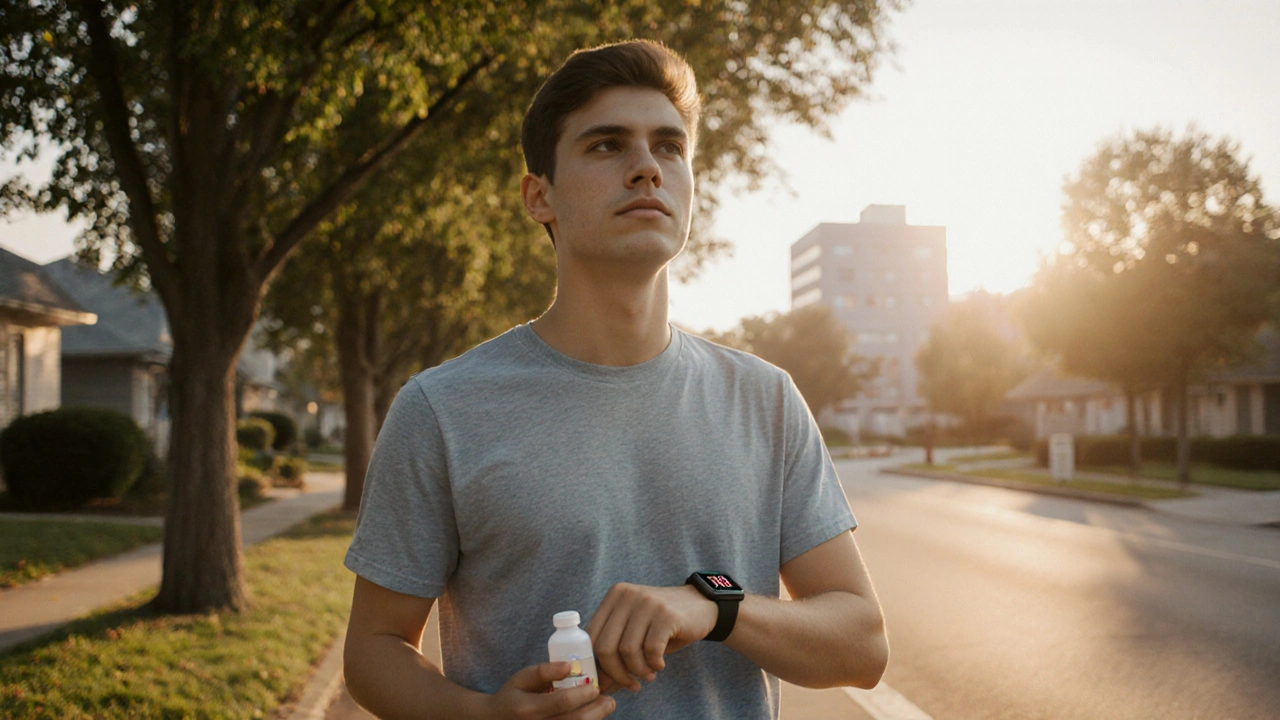Hepatitis C Exercise Heart Rate Calculator
This calculator helps determine your safe exercise heart rate zone (50-70% of maximum heart rate) based on your age. Staying within this range supports liver health while reducing risks during Hepatitis C treatment.
Remember: Exercise intensity should match your current health status. Always consult your healthcare provider before starting a new exercise routine.
Your Safe Exercise Zone
Maximum Heart Rate: -- bpm
Target Zone: -- bpm
(50%-70% of your maximum heart rate)
This zone promotes liver health while minimizing stress on your body during Hepatitis C treatment.
Living with Hepatitis C can feel like a constant juggling act-medication schedules, doctor visits, and the everyday fatigue that tags along. But what if a simple habit like moving your body could tip the scales toward better health? Below we explore why staying active isn’t just safe for people with Hepatitis C, it’s actually a powerful ally in the fight against the virus.
Hepatitis C is a chronic viral infection that primarily attacks the liver, leading to inflammation, scarring, and, if untreated, serious complications such as cirrhosis or liver cancer. Exercise refers to planned, structured physical activity designed to improve or maintain fitness is often the missing piece in managing this condition.Key Takeaways
- Regular physical activity improves liver function and reduces disease progression.
- Exercise boosts cardiovascular health, muscle strength, and overall quality of life.
- Safety guidelines make it easy to start a routine, even during antiviral treatment.
- Managing fatigue with low‑intensity workouts helps keep energy levels steady.
- Consulting healthcare providers before beginning ensures the plan fits your medical profile.
Why Exercise Matters for Hepatitis C
Several studies have shown that people who stay active experience slower liver fibrosis and better response to medication. Moving your body stimulates blood flow, delivering more oxygen and nutrients to liver cells, which helps them regenerate and clear toxins faster.
Beyond the liver, Cardiovascular health covers the heart and blood vessels, which are often stressed by chronic inflammation. Regular aerobic sessions-like brisk walking, cycling, or swimming-lower blood pressure and improve cholesterol profiles, reducing the extra burden chronic disease places on the heart.
Physical activity also invigorates the Immune system the body’s defense network that fights infections and repairs tissue damage. A more responsive immune system can better control viral replication, which translates into fewer flare‑ups and smoother treatment courses.
How the Liver Reacts to Physical Activity
The liver is a metabolic hub-it processes nutrients, filters blood, and stores energy. When you exercise, muscles demand glucose and fatty acids. The liver steps up, releasing glucose into the bloodstream and breaking down stored fat. This back‑and‑forth helps maintain stable blood sugar levels, a key factor for patients prone to insulin resistance.
Regular activity also promotes the release of myokines, proteins produced by muscles that have anti‑inflammatory effects. These molecules travel to the liver, dampening the chronic inflammation that fuels fibrosis. In short, exercise creates a two‑way conversation between muscle and liver that keeps both healthier.

Safe Exercise Guidelines for Hepatitis C Patients
Starting an exercise plan doesn’t require a gym membership or a marathon‑training schedule. The goal is consistency, not intensity. Below are straightforward guidelines that fit most treatment plans.
- Frequency: Aim for at least three sessions per week.
- Duration: Begin with 15‑20 minutes and gradually work up to 30‑45 minutes.
- Intensity: Keep heart rate in the “moderate” zone-roughly 50‑70% of your maximum (you can estimate max HR as 220 minus your age).
- Type: Mix low‑impact cardio (walking, stationary bike, water aerobics) with light resistance work (bodyweight squats, resistance bands).
- Warm‑up & cool‑down: Spend 5 minutes each on gentle stretching or marching in place to protect joints and reduce post‑exercise soreness.
Listening to your body is crucial. If you notice persistent abdominal pain, jaundice, or sudden worsening of fatigue, pause and contact your hepatologist.
Managing Fatigue and Energy Levels
Chronic fatigue is a common companion of Hepatitis C, especially during the early weeks of antiviral therapy. Here’s how to keep energy steady while staying active:
- Start small: A 10‑minute walk after breakfast can be less taxing than an hour‑long gym session.
- Time it right: Many patients feel most energetic mid‑morning or early evening. Schedule workouts during these windows.
- Stay hydrated: Dehydration amplifies fatigue. Aim for 2‑3L of water daily, more if you sweat heavily.
- Fuel smart: Pair carbs with protein-like a banana with a handful of nuts-to sustain blood sugar.
- Rest days are real: One or two low‑key days each week let muscles repair and prevent burnout.
By tweaking timing and intensity, you can reap the benefits of movement without feeling wiped out.
Exercise and Antiviral Treatment Interactions
Modern direct‑acting antivirals (DAAs) have transformed Hepatitis C therapy, achieving cure rates above 95%. However, side effects-headaches, joint pain, mild anemia-can affect workout performance.
Research indicates that moderate exercise does not interfere with drug metabolism. In fact, staying active may reduce the severity of side effects by improving circulation and promoting overall well‑being. Just keep these points in mind:
- If you’re on a ribavirin‑containing regimen (less common now), monitor for anemia. Light resistance work is preferable over high‑intensity cardio.
- Should you experience severe nausea, opt for low‑impact activities like yoga or gentle stretching.
- Coordinate with your healthcare team; they can adjust medication timing to fit your preferred workout window.

Building an Exercise Routine: Practical Tips
Turning intention into habit is where many stumble. Use these tactics to lock in consistency:
- Set a concrete goal: “Walk 20minutes on Tuesdays and Thursdays” is clearer than “exercise more”.
- Use a calendar or app: Mark workouts like appointments. Visual reminders reinforce commitment.
- Pick a buddy: Exercising with a friend or family member adds accountability and makes sessions more enjoyable.
- Mix it up: Rotate between cardio, strength, and flexibility to keep boredom at bay and work different muscle groups.
- Celebrate milestones: After a month of consistency, treat yourself to a new pair of walking shoes or a massage.
Remember, the best routine is the one you’ll actually follow.
Common Pitfalls & When to Pause
Even with the best plan, setbacks happen. Here are red flags that signal it’s time to rest or seek medical advice:
- Sharp or persistent abdominal pain.
- New yellowing of the skin or eyes.
- Unexplained swelling in the legs or abdomen.
- Sudden drop in exercise performance despite unchanged effort.
- Fever or signs of infection.
If any of these appear, stop exercising and contact your hepatologist promptly. Often, a short break or a tweak to your regimen resolves the issue.
Quick Reference: Exercise Recommendations for Hepatitis C
| Exercise Type | Duration per Session | Frequency per Week | Intensity |
|---|---|---|---|
| Brisk walking / stationary bike | 20‑30min | 3‑5 days | Moderate (50‑70% max HR) |
| Resistance band routine | 15‑20min | 2‑3 days | Light‑to‑moderate (12‑15 reps per set) |
| Yoga / gentle stretching | 10‑15min | Daily or as needed | Low (focus on mobility) |
Frequently Asked Questions
Can I start exercising the day I get diagnosed?
Yes, gentle activity like walking or light stretching is safe for most newly diagnosed patients. However, get clearance from your doctor to rule out any severe liver complications.
Will exercise speed up my cure?
Exercise doesn’t directly kill the virus, but it improves liver function and immune response, which can help your body tolerate antiviral medication better and reduce side effects.
Is there any exercise I should avoid?
High‑impact or heavy‑weight training that spikes blood pressure dramatically should be limited, especially if you have advanced fibrosis or portal hypertension. Stick to moderate cardio and light resistance.
How do I know if my fatigue is from the virus or the workout?
Track your energy levels before and after each session. If fatigue persists for days regardless of activity, it’s likely disease‑related. Adjust intensity or talk to your clinician.
Can I exercise while on antiviral pills?
Moderate exercise is safe alongside most direct‑acting antivirals. Just keep an eye on any new side effects like joint pain or nausea and modify your routine accordingly.
Staying active isn’t a luxury-it’s a practical tool that can improve liver health, boost mood, and help you sail through treatment with more energy. Start small, stay consistent, and let movement become a regular part of your Hepatitis C journey.

Use moderate‑intensity cardio (50‑70% max HR) 3×/week; combine with light resistance bands to maintain muscle mass and support hepatic perfusion.
Wow! This guide is a game‑changer!!! Keep moving, keep smiling!!! Your liver will thank you!!!
Yo, don’t just sip water-crank that treadmill and blast those myokines! Push harder, feel the burn, and watch that virus tremble!
Living with Hepatitis C can feel like walking through a fog, but adding movement can be the light that guides you out of the haze.
When you engage in regular aerobic activity your heart pumps more blood, delivering oxygen and nutrients that the liver desperately needs to repair damaged cells.
Each step you take signals your muscles to release myokines, those tiny anti‑inflammatory messengers that travel straight to the liver and calm the chronic inflammation that fuels fibrosis.
The synergy between muscle and liver creates a feedback loop where improved liver function further enhances your stamina, making workouts feel easier over time.
Even on days when antiviral therapy drags you down, a gentle 10‑minute walk after breakfast can reset your energy budget and prevent the dreaded crash.
Consistency beats intensity; three to five modest sessions a week are far more beneficial than an occasional marathon that leaves you exhausted.
Remember to calculate your safe heart‑rate zone-220 minus your age gives a rough max, and staying between 50 % and 70 % keeps stress low while still promoting circulation.
If you ever feel light‑headed or notice abdominal pain, drop the intensity immediately and check in with your hepatologist; safety always comes first.
Hydration is another secret weapon-2 to 3 liters of water a day helps the liver flush toxins and supports overall metabolism.
Pairing carbs with a pinch of protein, like a banana with a handful of nuts, stabilizes blood sugar and fuels longer sessions without the mid‑workout slump.
Strength training doesn’t have to involve heavy dumbbells; resistance bands or body‑weight squats activate the same pathways that aid glucose handling and fat oxidation.
Over time, studies have shown that patients who maintain an active lifestyle experience slower fibrosis progression and respond better to direct‑acting antivirals.
Mental health also lifts with movement-the release of endorphins combats the anxiety and depression that can accompany chronic illness.
Set realistic goals, like ‘walk 20 minutes on Tuesdays and Thursdays,’ and track them in a phone app to turn exercise into a habit rather than a chore.
Celebrate milestones-whether it’s a new pair of shoes or a week of uninterrupted workouts-because reward loops keep motivation alive.
So strap on those sneakers, breathe deep, and let each heartbeat remind you that you’re actively fighting back against Hepatitis C. 🌟💪
The pep‑talk vibe is cute, but the article skirts the real danger of overexertion in portal hypertension patients; you can't just throw a party for your liver.
Exercise is a solid part of the plan.
Listen up, you think a casual stroll will cure the virus? Think again. The liver is a stubborn organ that demands disciplined effort, not fairy‑tale optimism. Every rep, every breath you take chips away at the fibrosis, forging resilience. So stop whining and lace up those shoes!
Hey there, I totally get how overwhelming Hepatitis C can feel 😔.
Remember, tiny steps add up, so a 5‑minute walk is still a win 🚶♀️.
Keep listening to your body, stay hydrated, and celebrate each little victory 🎉.
The recommendations are clear and practical it’s easy to adopt a routine without feeling rushed.
While the philosophical musings are poetic, the practical takeaways get lost in the verbosity; readers need bullet points, not an essay.
The emphasis on myokines is intriguing but may confuse laypersons unfamiliar with the term.
A concise table summarising safe heart‑rate zones and activity types would serve better.
Additionally, the warning about portal hypertension deserves a highlighted box for quick reference.
Overall, the heart is in the right place, yet clarity suffers under the weight of wanderlust prose.
Im realy think tis article could use more real world examplles for peopel on meds. The stuff is good but some parts a bit overcomplicated.